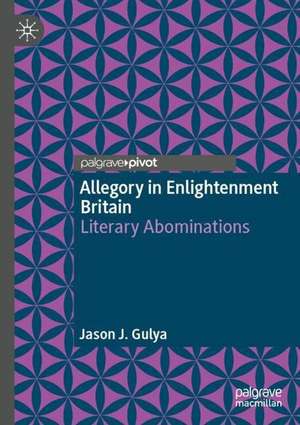Allegory in Enlightenment Britain: Literary Abominations
Autor Jason J. Gulyaen Limba Engleză Hardback – 3 dec 2022
Preț: 349.49 lei
Nou
Puncte Express: 524
Preț estimativ în valută:
66.87€ • 70.01$ • 55.33£
66.87€ • 70.01$ • 55.33£
Carte tipărită la comandă
Livrare economică 05-19 aprilie
Preluare comenzi: 021 569.72.76
Specificații
ISBN-13: 9783031190353
ISBN-10: 3031190351
Pagini: 99
Ilustrații: XI, 99 p.
Dimensiuni: 148 x 210 x 13 mm
Greutate: 0.29 kg
Ediția:1st ed. 2022
Editura: Springer International Publishing
Colecția Palgrave Macmillan
Locul publicării:Cham, Switzerland
ISBN-10: 3031190351
Pagini: 99
Ilustrații: XI, 99 p.
Dimensiuni: 148 x 210 x 13 mm
Greutate: 0.29 kg
Ediția:1st ed. 2022
Editura: Springer International Publishing
Colecția Palgrave Macmillan
Locul publicării:Cham, Switzerland
Cuprins
1 Introduction: How the British Enlightenment Transformed Allegory.- 2 How Bunyan’s Anxieties About Allegory Sparked a Culture of Experimentation.- 3 How Dryden Created an Abomination that Would Haunt the Next Century.- 4 How Prose Experiments Dissected Allegory.- 5 How Critics Retrofitted Rules for Allegory.
Notă biografică
Jason J. Gulya is Professor of English at Berkeley College, USA, where he teaches courses on literature, composition, film, and the humanities more broadly. Over the last decade, he has taught at Berkeley, Rutgers University, Raritan Valley Community College, and Brookdale Community College. As a professor, he has earned various prestigious awards, including his college’s Faculty of the Year Award for Excellence in Teaching in 2020 and Rutgers University’s Dissertation Teaching Award in 2015.
Textul de pe ultima copertă
"Offering a fresh, nuanced reading, Jason Gulya argues that the death of allegory during the Enlightenment has been greatly exaggerated. He illustrates how writers adapted allegory, a genre he sees as supple enough to accommodate the new and experimental ways of understanding the world that characterizes Enlightenment thinking and writing."
-Sharon Harrow, Professor of English at Shippensburg University of Pennsylvania, USA.
This Palgrave Pivot argues for the significance of allegory in Enlightenment writing. While eighteenth-century allegory has often been dismissed as an inadequate form, both in its time and in later scholarship, this short book reveals how Enlightenment writers adapted allegory to the cultural changes of the time. It examines how these writers analyzed earlier allegories with scientific precision and broke up allegory into parts to combine it with other genres. These experimentations in allegory reflected the effects of empiricism, secularization and a modern aesthetic that were transforming Enlightenment culture. Using a broad range of examples – including classics of the genre, eighteenth-century texts and periodicals – this book argues that the eighteenth century helped make allegory the flexible, protean literary form it is today.
Jason J. Gulya is Professor of English at Berkeley College, USA, where he teaches courses on literature, composition, film, and the humanities more broadly. Over the last decade, he has taught at Berkeley, Rutgers University, Raritan Valley Community College, and Brookdale Community College. As a professor, he has earned various prestigious awards, including his college’s Faculty of the Year Award for Excellence in Teaching in 2020 and Rutgers University’s Dissertation Teaching Award in 2015.
-Sharon Harrow, Professor of English at Shippensburg University of Pennsylvania, USA.
This Palgrave Pivot argues for the significance of allegory in Enlightenment writing. While eighteenth-century allegory has often been dismissed as an inadequate form, both in its time and in later scholarship, this short book reveals how Enlightenment writers adapted allegory to the cultural changes of the time. It examines how these writers analyzed earlier allegories with scientific precision and broke up allegory into parts to combine it with other genres. These experimentations in allegory reflected the effects of empiricism, secularization and a modern aesthetic that were transforming Enlightenment culture. Using a broad range of examples – including classics of the genre, eighteenth-century texts and periodicals – this book argues that the eighteenth century helped make allegory the flexible, protean literary form it is today.
Jason J. Gulya is Professor of English at Berkeley College, USA, where he teaches courses on literature, composition, film, and the humanities more broadly. Over the last decade, he has taught at Berkeley, Rutgers University, Raritan Valley Community College, and Brookdale Community College. As a professor, he has earned various prestigious awards, including his college’s Faculty of the Year Award for Excellence in Teaching in 2020 and Rutgers University’s Dissertation Teaching Award in 2015.
Caracteristici
Shows how modern allegory derived from allegory in the Enlightenment Explores how Enlightenment writers adapted allegory in context Draws on classics of the genre, 18th-century texts and periodicals
